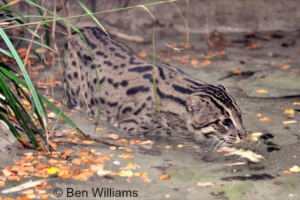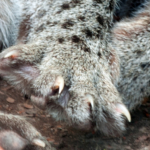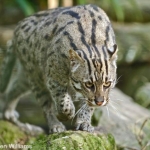In November 2015, the First International Fishing Cat Conservation Symposium was held in Nepal, hosted in association with the NGOs Himalayan Nature and Small Mammals Conservation and Research Foundation. Participants included representatives from Fishing Cat range countries like Nepal, India, Sri Lanka, Cambodia and Bangladesh, as well as conservationists from USA, UK, Spain and Germany.
 The endangered Fishing Cat Prionailurus viverrinus is at home near water bodies. This unique cat has been known to science since the early 19th century. However, its recent discovery in mangroves along the east coast of India and in Cambodia reveals that still little is known about its distribution and ecological needs. In Asia, wetlands are rapidly being devastated, which results in declining Fishing Cat populations in all range countries.
The endangered Fishing Cat Prionailurus viverrinus is at home near water bodies. This unique cat has been known to science since the early 19th century. However, its recent discovery in mangroves along the east coast of India and in Cambodia reveals that still little is known about its distribution and ecological needs. In Asia, wetlands are rapidly being devastated, which results in declining Fishing Cat populations in all range countries.
Furthermore, they are threatened by killings in retaliation, poaching and traffic. Their status in Pakistan, Myanmar, Thailand, Vietnam and Java is largely unknown. They may have declined dramatically over the last decades.
“This dire perspective across their range motivated us to form the Fishing Cat Working Group in 2011. Our symposium was a huge success. We are the first Working Group who developed a conservation strategy for an Asian small wild cat. Fishing Cats need more targeted conservation efforts to ensure their continued survival in the wild. Our vision is that wild Fishing Cat populations become viable again across their native range, are valued globally and live in harmony with humankind.” said Angie Appel, co-founder and coordinator of the Fishing Cat Working Group.
“In India, they are included in Schedule I of the Wildlife Protection Act, 1 972, along with the tiger, and thus deserve protection measures of the highest accord. Nevertheless, their most important habitats are destroyed by the filling up of wetlands for airports, residential areas and highways due to policy contradictions.” said Tiasa Adhya. She has been engaged in conserving Fishing Cats in West Bengal. Because of her successful efforts she was recently nominated for the Future for Nature award. Giridhar Malla from the Wildlife Institute of India added “A viable population of Fishing Cats was recently recorded in mangroves of Andhra Pradesh. However, oil refineries and expansion of road network pose a huge threat to this population.”
“In Nepal, Fishing Cats have been recorded in protected areas and recently also in human dominated landscapes in the Terai. However, we still don’t know all the specific sites where Fishing Cats are present. Furthermore, they are not listed as a priority protected species in the country.” said Sagar Dahal of the Small Mammals Conservation and Research Foundation.
“Ecological studies on Fishing Cats are scarce even though they live throughout coastal wetlands and hill forests of Sri Lanka.” said Anya Ratnayaka. She radio-collared the first Fishing Cat in suburban Colombo to understand their ecological adaptions to novel urban habitats. “In Sri Lanka, more than 50 individuals died in road accidents during the past two years.” added Ashan Thudugala. In response he installed road signs in the country’s central hills to minimize road accidents involving Fishing Cats.
“In Cambodia, Fishing Cats are poorly studied. Our recent discovery of a Fishing Cat population in mangroves is spectacular. This is not only the first record since 2003, but also in a previously undocumented site.” said Ret Thaung of the Centre for Biodiversity Conservation (CBC) of the Royal University of Phnom Penh. “We are very excited about this discovery because it gives us new hope for the recovery of Fishing Cats in Southeast Asia.” said Vanessa Herranz Muñoz who collaborates with CBC.
“Conservationists in Fishing Cat range countries need to be better linked with the international zoological community for exchange of knowledge. We can increase awareness about the plight of Fishing Cats in the wild and support conservation efforts through fund raising activities.” said Neville Buck of the Aspinall Foundation, UK.
 The objectives of the first Conservation Strategy Plan revolve around three major themes, namely ecological, socio-cultural and policy issues. Participants pledged to implement planned activities within the next five years. They will collaborate in developing manuals for policy makers and researchers as well as comprehensive habitat and distribution maps. They will continue to work with local communities and address Fishing Cat conservation needs through advocacy networks. Information material will be created to raise awareness amongst global stakeholders, both young and old.
The objectives of the first Conservation Strategy Plan revolve around three major themes, namely ecological, socio-cultural and policy issues. Participants pledged to implement planned activities within the next five years. They will collaborate in developing manuals for policy makers and researchers as well as comprehensive habitat and distribution maps. They will continue to work with local communities and address Fishing Cat conservation needs through advocacy networks. Information material will be created to raise awareness amongst global stakeholders, both young and old.
The symposium was supported by the Mohamed bin Zayed Species Conservation Fund, the Cincinnati Zoo & Botanical Garden, the Fishing Cat Fund and the Department of National Parks and Wildlife Conservation, Nepal. It was held at Park River View Resort in Nawalparasi close to Chitwan National Park.
–
Information taken from the Proceedings Of the First International Fishing Cat Conservation Symposium held in Nepal last year.
